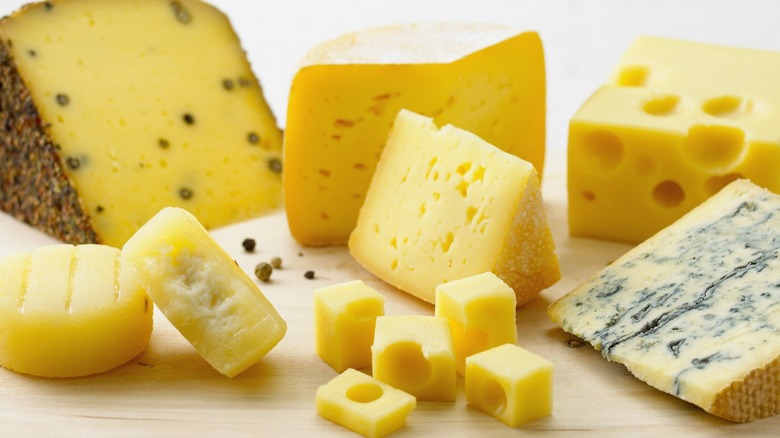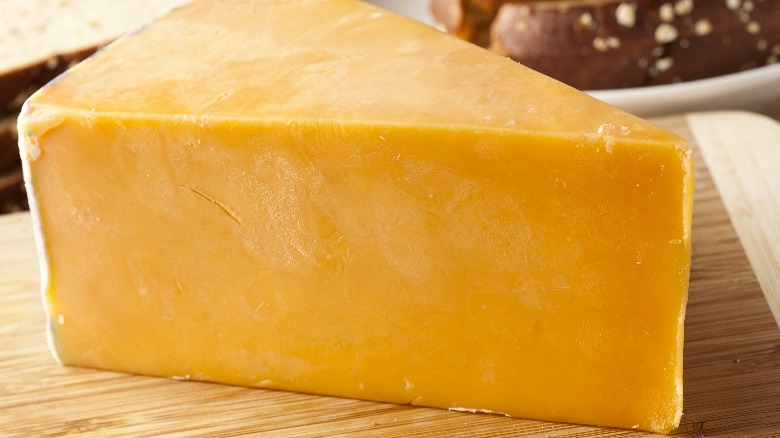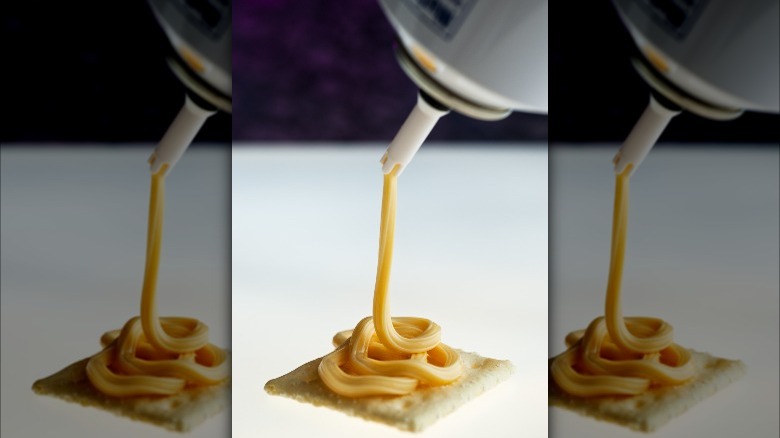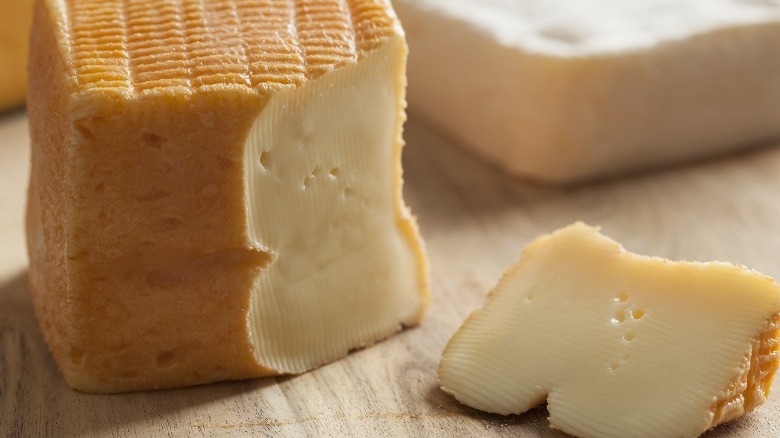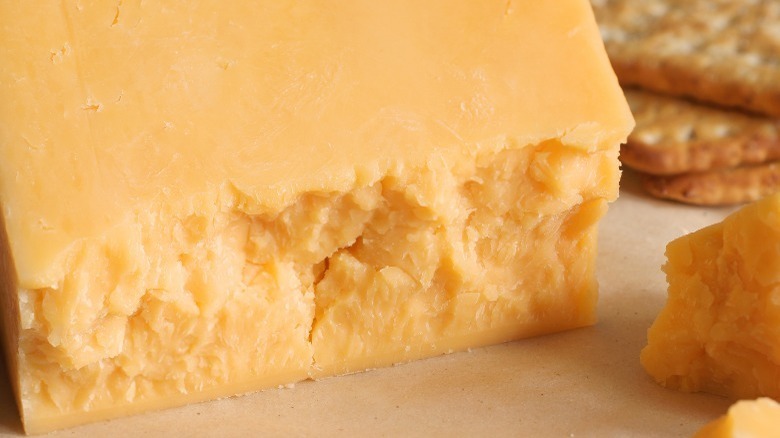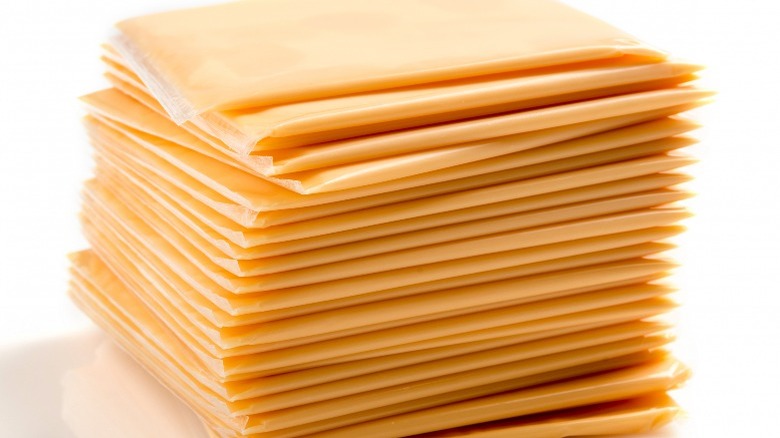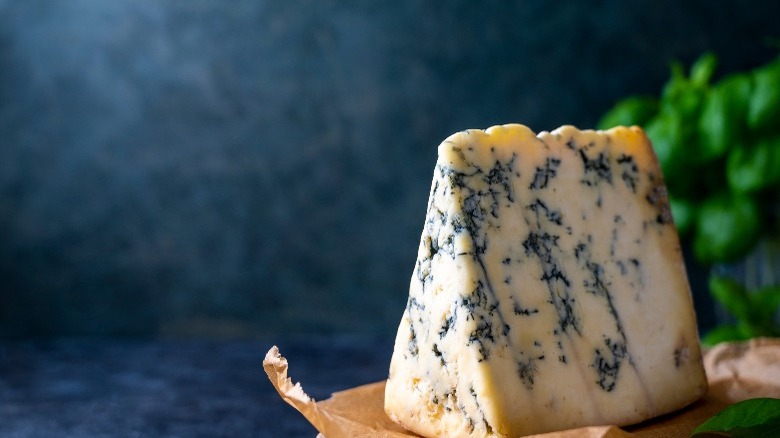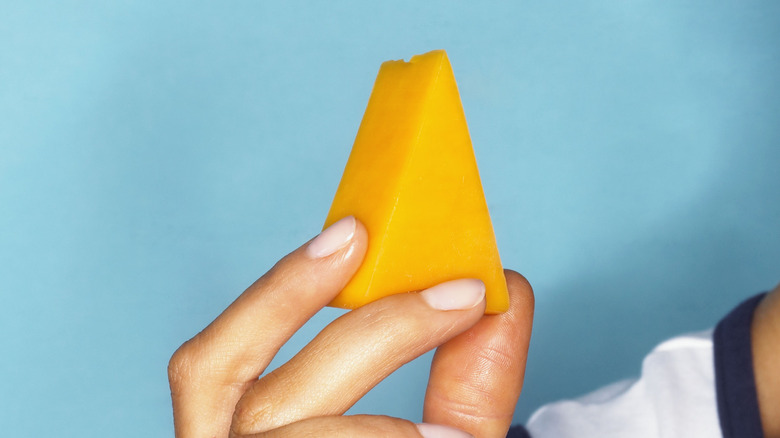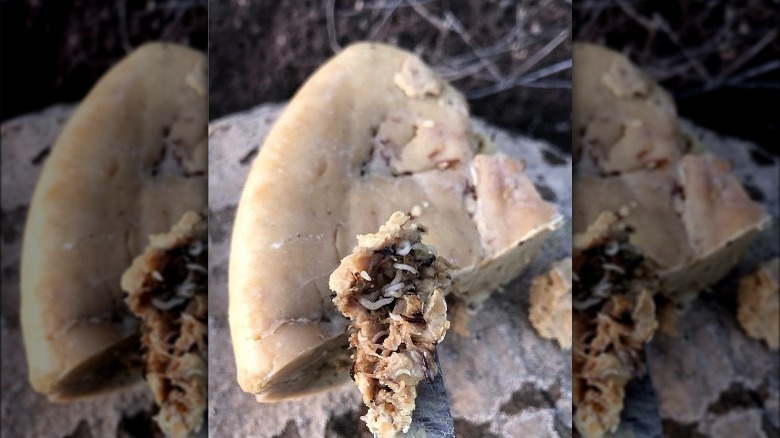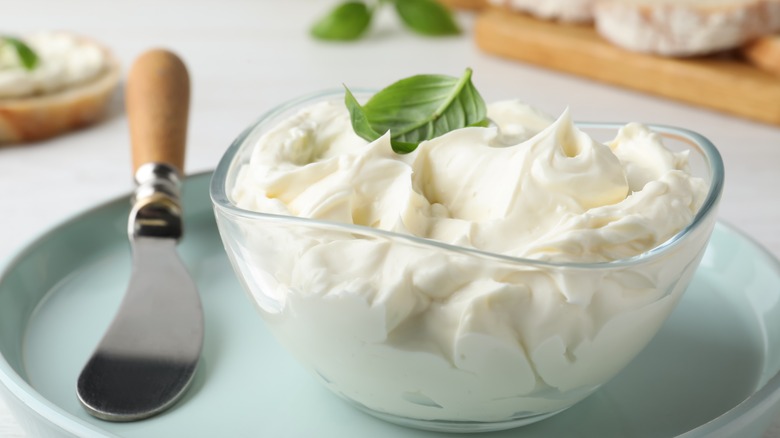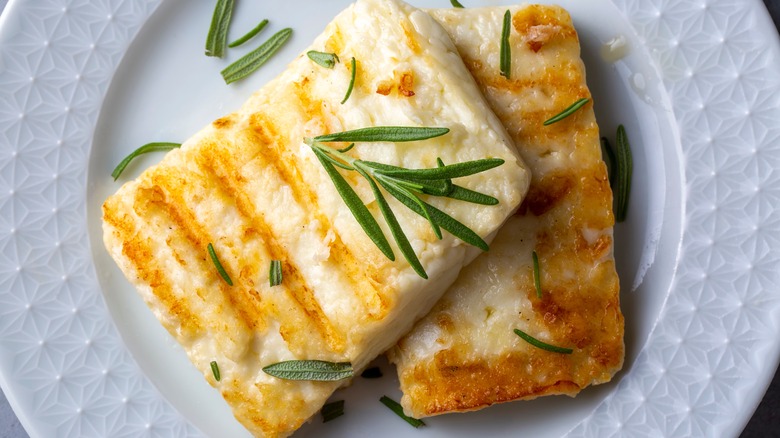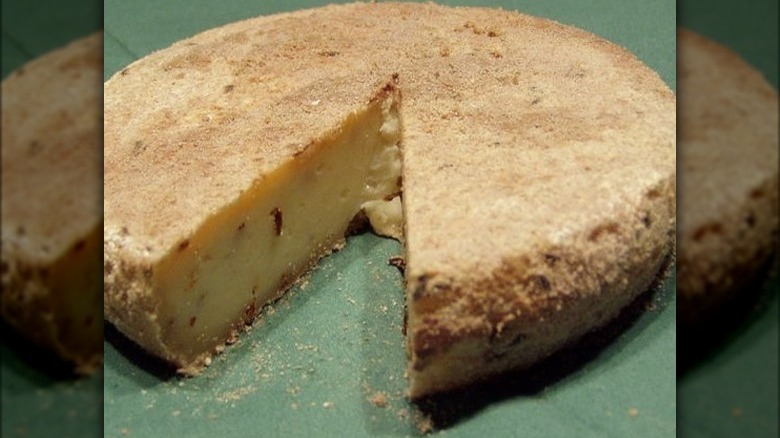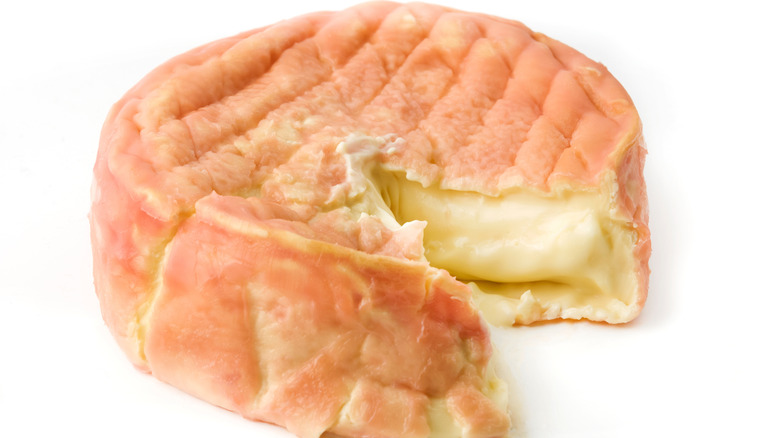These Are The Cheeses You Want To Avoid Eating At All Costs
There's no denying it: cheese is delicious, and a life without cheese is hard for many of us to imagine. From nutty, sweet Emmenthal to salty Halloumi to sharp cheddar to creamy Camembert, everyone has their own favorite type of cheese they can't live without.
Cheese is an essential ingredient in so many recipes, from pizzas to tacos, mac and cheese to baked potatoes. Yet it often gets called unhealthy due to the high salt and saturated fat content of many types of cheese. Some cheeses are healthier than others, some you should enjoy in moderation, and then there are some you should avoid eating at all costs.
We look at a few of the types of cheese you should stay away from. On the list, you'll find some cheeses that aren't the healthiest choices, some that are exceptionally pungent, and even one that's dangerous to eat and has been banned in the U.S.
Camembert
When you're craving soft, creamy, delicious cheese, resisting an oozing baked Camembert fresh from the oven, drizzled with honey and sprinkled with walnuts, is almost impossible. With veggies and crusty bread on the side for dunking, the temptation is complete.
Bad news, though: camembert isn't the healthiest choice. While it's true that this cheese is an excellent source of protein, it's very high in fat. It sits at around 23% fat, with approximately 14% of it saturated.
It's also packed with salt, with 1.5 grams or more per 100 grams depending on the brand you buy. As for those deep-fried camembert sticks or wedges? They're an even less healthy choice, so we'd recommend avoiding them at all costs.
If you really do have to have Camembert, share it with friends. You'll consume fewer calories and less fat and salt than if you were tucking into a whole baked cheese alone or with your other half. You can skip the crusty bread and serve pickles and raw vegetables like cucumber and carrot sticks for dipping, too.
Cheddar
Cheddar is one of the most popular types of cheese, with many people in the U.S., U.K., and the rest of Europe eating it on a regular basis. Unfortunately, cheddar isn't a great choice for your health or your waistline.
Cheddar cheese is extremely high in both fat and salt, with around 33.3 grams of fat per 100 grams of cheese — a lot higher than the fat content of cheeses like mozzarella or feta. A one-ounce serving (28 grams) of a certain brand of cheddar contained a whopping 120 calories and 190 milligrams of sodium, with 10 grams of fat (6 grams of which is saturated).
While adding cheddar to your grilled cheese or jacket potato isn't necessarily a bad thing, it's best enjoyed as an occasional treat rather than an everyday addition to your diet due to its high fat and salt content. Some kinds of cheddar also have added color, made from annatto. While this is a plant-based food coloring that comes from the annatto tree, it's still an additive which can potentially trigger allergies or irritable bowel syndrome (IBS) in some people (via Healthline).
You might not want to avoid cheddar altogether, but there are definitely healthier cheeses you can eat more regularly. Cottage cheese, feta, and ricotta cheese are all great alternatives.
Spray cheese
Do we really need to explain why spray cheese is a cheese you should avoid? First up, it's highly processed, and as we all know, processed food isn't a healthy choice. It's also usually a bright orange color, indicating that colors such as apocarotenal have been added.
But is spray cheese even really cheese? We say nope. Spray cheese's typical ingredients include nasties like sodium phosphate, sodium citrate, sodium alginate, lactic acid, canola oil, milk protein concentrate, and whey. This stuff is so far removed from real cheese that it's unreal — and it's not even especially cheesy. Spray cheese is also very high in salt, containing almost twice as much salt as other cheeses.
We'd definitely avoid spray cheese, and we don't recommend feeding it to your kids, either. All that salt, fat, and artificial ingredients are bad news. We say keep spray cheese where it belongs: away from your tastebuds and in the can.
Limburger
Originating in the Limburg region of Europe, today part of the Netherlands, Germany, and Belgium, Limburger is an exceptionally pungent cheese. In simple terms, it smells awful, though if you're into stinky cheese, this might well be your thing.
Thankfully, this cheese isn't that popular in the U.S. However, it's produced at Chalet Cheese Co-op in Wisconsin, the only producer of Limburger in the States. We won't be heading there anytime soon, and if you're not a fan of smelly cheese, we don't recommend it for your next road trip.
What makes the cheese so pongy? Bacteria called Brevibacterium linens are smeared onto the cheese to start the fermentation process. This bacterium is the same type responsible for body odor on human skin. The fermentation process takes around three months, with the cheese becoming more odorous by the day. We really wouldn't like to be a fly on that cheese plant's wall.
If you don't want people to recoil from you physically, this is definitely a cheese we recommend you avoid eating, buying, or being in the vicinity of. It really does smell bad, and the flavor is pungent, too.
Double Gloucester
Though it's not widely available in the U.S. — so it's unlikely to be a favorite cheese for many Americans — the popular British cheese Double Gloucester is one of the highest-calorie cheeses out there. This strong, savory cheese has a whopping 415 calories per 100 grams. It also contains 35 grams of fat and 21.9 grams of saturated fat per 100 grams, with 1.7 grams of salt.
If you do pick up some Double Gloucester from your local deli or on a trip to the U.K., then make sure you eat it sparingly. Luckily, its strong flavor means it's a sharp addition to sandwiches or grilled cheese, so you won't need to use much to make an impact.
Its high calorie, fat, and salt content make Double Gloucester one of the least healthy cheeses on the market. It's definitely one to avoid eating at all costs, particularly if you're trying to follow a healthy eating plan or lose weight. There are cheeses that are lower in fat and calories that you can enjoy if this applies to you.
American cheese
American cheese isn't a great option as it's so heavily processed. Yes, its oozy, melty qualities ensure it's great on burgers. But no, it isn't the best choice for your health.
Did you know that American cheese is only required by law to be 51% cheese? FDA guidelines on what can be classified as cheese state that Kraft Singles, one of the most popular American cheese products, is a "cheese product" because it contains less than 51% cheese.
This type of cheese, which often comes prepackaged as individually wrapped slices, is also loaded with other unhealthy ingredients and high in saturated fat. These ingredients include things like milk protein concentrate (MPC), a powder made from milk with minerals, liquid, and fats removed; apocarotenal to add color; calcium phosphate; sodium phosphate; cheese cultures; and lactic acid. Kraft Singles and other processed cheese slices also often contain the natural cheese preservative natamycin, a mold inhibitor. While it's a natural ingredient, it has been banned by Whole Foods since 2003.
This type of cheese is packed with salt too, with a single Kraft cheese slice containing around 10% of your daily recommended sodium intake at 230 milligrams per slice. As if you needed any more reasons to avoid American cheese, all that processing is resource intensive, so producing this type of heavily processed cheese isn't great news for the environment. Not to mention, it doesn't even taste that great, so it's definitely a cheese to avoid.
Blue cheese
Our suggestion to avoid blue cheese comes with a caveat: It shouldn't be eaten by pregnant women, babies, or young children. That's because blue-veined cheeses such as Roquefort or Stilton are made with cultures from Penicillium mold and have a higher risk of carrying bacteria called Listeria that could lead to illness.
If you don't fall into one of these groups, blue cheese is actually not the worst choice. It's higher in calcium than some other cheeses, providing 12% of your DV, which could help prevent issues relating to bone health, and can be part of a healthy diet when enjoyed in moderation.
However, some kinds of blue cheese are high in sodium, like Roquefort, with around 3.6 grams of salt per 100 grams. One popular brand of Roquefort sold in the U.K. contained 32 grams of fat and 20 grams of saturated fat per 100 grams.
Though blue cheese can be high in calories, its pungent smell and strong, sharp flavor mean you can use it sparingly. By crumbling some blue cheese over salads or using it to top burgers or pizzas, you'll be consuming fewer calories, fat, and salt than if you enjoyed a huge wedge of blue cheese as part of a cheeseboard, and you'll still enjoy the salty tanginess.
Low-fat cheese
Opting for low-fat alternatives to high-fat foods might seem like a good choice, but these "healthy" alternatives often have added ingredients that could be harmful to your health. Instead of choosing low-fat cheese, it's better to cut out cheese altogether or opt for a healthier cheese that's naturally lower in fat.
Some low-fat cheeses, such as Kraft Reduced Fat Sharp Cheddar Cheese, could include ingredients like cheese culture, annatto, vitamin A palmitate, modified cornstarch, and natamycin. Pick up a regular block of cheddar and you won't find many of these ingredients listed.
By choosing low-fat cheese, you may not only be unintentionally adding harmful ingredients to your diet, but you'll also miss out on many of the heart-healthy benefits of full-fat cheese. Cheese naturally contains HDL cholesterol, the "good" cholesterol; a recent study published in the American Journal of Clinical Nutrition showed that regular-fat cheese contains more of the good stuff than the low-fat varieties, which could help prevent heart attacks and strokes. Full-fat cheese also doesn't impact LDL cholesterol levels, the "bad" cholesterol.
Taste tests have shown that reduced-fat cheese simply doesn't taste as good as the full-fat variety, either. Yet another reason to skip the low-fat options and go for regular cheese in moderation.
Casu marzu
This Sardinian cheese's name literally means "rotten cheese." How is it rotten, you might ask? It contains live maggots, or cheese fly larvae — yes, you read that right. Piophila casei, or cheese skipper flies, lay their eggs in cracks in the cheese, and, when hatched, digest its proteins to create a creamy and soft, often liquidy texture.
Not only does this make the cheese look less than appealing — and we're being polite here — it also makes it exceedingly pungent and soft. But the real horror of this cheese, and the main reason you'll want to avoid it, is that it was proclaimed the most dangerous cheese in the world by the Guinness World Records in 2009 (via CNN).
There are rumors casu marzu, often known as casu becciu or formaggio marcio, is an aphrodisiac. However, not only are the live maggots in the cheese disgusting, but they could cause serious illness. If they survive in the small intestine, they could cause micro-perforations, though no cases of this have ever been linked to the cheese.
Thankfully, casu marzu has been illegal across Italy since 1962, and anyone selling it faces a high fine. That hasn't stopped locals from enjoying it, though; it's been eaten in Sardinia for centuries and is commonly served at weddings and celebrations. Casu marzu is also banned in the U.S. This is definitely a cheese we recommend you avoid at all costs. We'll be doing the same.
Cheese with fruit
Any cheese with added fruit — like the British favorite Wensleydale with cranberries — isn't great news for a healthy diet. By adding fruit to cheese, you're simply adding more sugar and calories to an already calorific food.
One popular brand of Wensleydale with cranberries sold in the U.K. contains 15.7 grams of sugar per 100 grams of cheese, as well as 365 calories, 25.6 grams of fat (of which 15.9 grams is saturated fat), and 1.3 grams of salt. It's not just hard or semi-soft cheese with added fruit you should avoid if you're trying to eat more healthily, though; this applies to cream cheese with added fruit, too.
Can't get enough of the sweet, savory combination of cheese and fruit? For a healthier option, try serving some fresh fruit alongside your cheeseboard. Grapes, apples, or figs are all great additions to a cheeseboard — but leave the cranberry Wensleydale off the menu.
Sweetened cream cheese
Eating foods with added sweeteners is bad news all around. Did you know that sweetened cream cheese often contains aspartame, and that artificial sweeteners could aggravate IBS symptoms?
Cream cheese is also pretty high in fat. U.S. government requirements state that all cream cheese must be at least 33% fat. It's not particularly high in protein either, with around 2 grams of protein per one-ounce serving.
If you're really craving cream cheese, at least opt for the all-natural variety without any added sweeteners. You could always top your cream cheese toasts or crackers with a light drizzle of honey or some fresh fruit to add sweetness more naturally.
Even better, swap your cream cheese for cottage cheese, as it's lighter, lower in fat, and a healthier option. Don't like the texture? Just whizz it up in your food processor or blender with some herbs and serve the smooth spread on crackers or with vegetables for dipping.
Halloumi
You might be surprised to see halloumi on this list, as the squeaky, salty Cypriot cheese is a favorite for many. Who can resist halloumi fries? It turns out you might want to if you're health conscious: breaded and deep-fried anything is bad news, but even more so when it comes to cheese.
Halloumi is high in salt and saturated fat, with 7.4 grams of fat, 5.1 grams of saturated fat, and 0.9 grams of salt per 30-gram serving. If you have high blood pressure, that's particularly bad news.
The good news? Halloumi is packed with protein, calcium, zinc (great for your immune system), phosphorus (for healthy bones), and vitamin A (for healthy skin and vision). It's also a great source of B vitamins like B12, B2, and folic acid that can help boost your energy levels.
It's okay to enjoy halloumi in moderation, so you don't need to avoid it completely unless you're watching your sodium intake. If you are going to eat it, enjoy it grilled and added to salad rather than breaded and fried.
Milbenkäse
Milbenkäse, also known as Mellnkase or Spinnenkäse (spider cheese), is a cheese exclusively produced in the village of Würchwitz in Saxony-Anhalt, Germany. The cheese's name means mite cheese, referring to the method of ripening this infamous cheese.
Milbenkäse is made from Quark, a soft cheese. Salt and caraway are added to the cheese before it's left to dry. Once dry, it's placed in a box with cheese mites and rye flour for around three months. Digestive enzymes excreted by the mites ripen the cheese. The resulting cheese has a zesty flavor with bitter notes that increase with age.
If the idea of cheese mites burrowing into your cheese to ripen it hasn't put you off, consider this: you'll end up eating any cheese mites that are still clinging to the rind of the cheese, too. Luckily, this cheese is pretty hard to come by in the U.S., so it should be pretty easy to avoid.
Epoisses de Bourgogne
Epoisses de Bourgogne was said to be Napoleon's favorite cheese. This cheese has been made in Bourgogne since the 16th century, with a recipe that's remained largely unchanged since the 19th century.
This soft cow's milk cheese is dried before moving to caves for ripening. A mix of Brevibacterium aurantiacum (which helps the cheese ripen), Marc de Bourgogne brandy, and water is used to wash the cheese several times a week. This results in a bright orange/pink wrinkly rind that has a sticky finish.
Boy, is this cheese pungent. In fact, it's one of the stinkiest around. An urban legend says that it's banned on Parisian public transport due to its pungent odor, though we're unsure how much truth there is to this. Common sense dictates you probably shouldn't get on public transport in any country with it, of course.
Despite its strong odor, Epoisses de Bourgogne's flavor is actually quite delightful, salty, spicy, and delicate — the perfect complement to a dark Belgian beer. Just don't travel with it.
